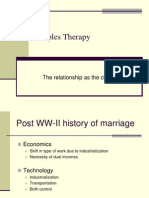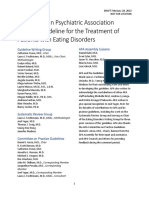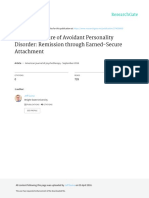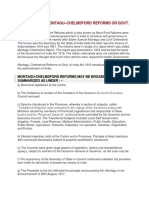Genogram Instructions.306150702 PDF
Genogram Instructions.306150702 PDF
Uploaded by
vimalaCopyright:
Available Formats
Genogram Instructions.306150702 PDF
Genogram Instructions.306150702 PDF
Uploaded by
vimalaOriginal Title
Copyright
Available Formats
Share this document
Did you find this document useful?
Is this content inappropriate?
Copyright:
Available Formats
Genogram Instructions.306150702 PDF
Genogram Instructions.306150702 PDF
Uploaded by
vimalaCopyright:
Available Formats
Genogram Worksheet
Barry Litt, MFT barrylittmft.com
EMDRIA Approved Consultant
I. Genogram History-Taking Questions
Preparation: Use graph paper and begin in the upper left corner
Questions:
1. Beginning with your Mothers Mother: what is/was her name? Deceased and
cause or Age? Ethnicity?
2. What was your Mothers Fathers name? Deceased or Age? Ethnicity?
3. Were your Mothers parents married to each other? Were either of them ever
divorced, separated, remarried, or have children outside the marriage? If so,
who, how many, etc.
4. How many children did your Mothers parents have together?
5. Your Mother was what number in the birth order? (Draw Mothers circle lower
than the rank of her sibs, to distinguish her visually from the rest. Identify her
sibs only if it seems useful at the time.)
6. In your Mothers lifetime, how many times has she been married? And children
by how many men? (List all husbands and men with whom she became pregnant.)
7. What is/was your fathers name? Age or year and cause of death?
8. Begin fathers family history as with questions 16 above.
9. In your parents lifetimes, were they ever divorced, separated, remarried, or have
children outside the marriage? If so, who, what ages, etc.
10. How many pregnancies did your parents have with each other? Include
miscarriages, stillbirths and/or abortions. (As before, draw the clients circle or
square at a lower rank than the sibs to distinguish it).
11. In your lifetime, how many partners have you either lived with, married, or had
pregnancies with? (List these chronologically.)
12. Establish custody and household membership of each child. Document marital or
cohabitation partners for each child, and any offspring they may have (i.e.,
grandchildren).
Genogram Worksheet 2
II. Risk Factors
Preparation: Draw a 5 X 3 grid on the paper to indicate yes or no to the following:
1. Of everybody in the family that you have named, who does or did abuse drugs
and or alcohol, including prescription medication? (Indicate on genogram)
2. Have you yourself ever had a problem with drugs and/or alcohol or medications?
(If yes, then document details)
3. Repeat questions 1&2 for Psychiatric illness, depression, anxiety, nervous
breakdowns, bad nerves, or suicide attempts.
4. Repeat questions 1&2 for Physical abuse, or corporal punishment that would be
considered excessive by todays standards?
5. Repeat questions 1&2 for Sexual abuse, or inappropriate sexual behavior,
touching, or fondling.
6. Repeat questions 1&2 for Emotional or verbal abuse, name calling or threats?
III. Relationship Assessment
Preparation: Use a red pen to indicate pathology, a blue or black pen to document
data.
1. How would you describe your parents marriage? (Document the quote, then ask
for elaboration)
2. What did your parents do to be helpful to one another?
3. Did your parents show affection? To each other? The kids?
4. How did your parents settle their differences? (Ascertain the tactics and defenses
used)
5. Did one or the other parent seem to have more say in decisions?
6. Did your parents have traditional gender roles?
7. Did either of your parents confide in you or one of your sibs about grievances
with the other parent?
8. Did you ever feel you had to take sides with one parent over the other?
9. Which parent are you most like? With whom are/were you closer?
10. What did each parent do for you? How did they take care of you? What did they
discuss, counsel or teach you?
11. How do things go now between you and your Mom? Dad? Who initiates contact?
12. What do you do to be helpful to your Mom? Dad?
13. Is your Mom/Dad pleased with you? How do you know? What do you do to
please him/her?
14. Are you able to say no to your parents? When have you? What does it cost
you?
15. Are you worried about your Mom/Dad? If so, why? What do you do with that?
16. Who is the favorite child of each parent? Are any of the sibs black sheep?
17. How do you get along with your sibs now and during childhood? How were
conflicts managed? What role did parents play in sib relationships?
18. What role do you play in your family?
19. What would you like to see change in your family? In your conduct with family
members?
Barry Litt, MFT barrylittmft.com
EMDRIA Approved Consultant
Genogram Worksheet 3
III. Relationship Assessment, Continued.
(Relationship with children of adult clients)
20. Establish the names, genders, ages, and custody status of each child
For each child in turn:
21. Was this child planned? Was this child wanted?
22. Were there any complications around the pregnancy or delivery?
23. What challenges did you face in raising this child?
24. Who contributed to raising this child?
25. What concerns do you have for this child?
26. What role does this child seem to play in the family?
27. Who is this child most like?
28. What does this child do to show care or loyalty to you? To the family?
29. Does this child know you are seeking help in therapy? What has this child been
told?
In the event of divorce or separation:
30. How does this child understand the reasons for the divorce/separation?
31. Who told the child what about this event?
32. Is this child expected to hold any secret information? From whom?
33. Who was/is available to this child to help cope with the event?
34. Does this child seem to take sides? Is the child expected to take sides?
In the event of a parents death or illness:
35. How old was this child when the parent died/became ill?
36. How does this child understand the cause/circumstances of the event?
37. Who told the child what about the event?
38. Who is emotionally available to this child about this?
39. Has the child taken part in the funeral/ill parents care?
40. How has this child been affected by this?
Barry Litt, MFT barrylittmft.com
EMDRIA Approved Consultant
You might also like
- Davis, Jonathan - The Opposite of Addiction Is ConnectionDocument3 pagesDavis, Jonathan - The Opposite of Addiction Is ConnectionKen Eduardo Avila RouraNo ratings yet
- Mbti Brochures Whole Set With CF Ab Edits Final 190515Document15 pagesMbti Brochures Whole Set With CF Ab Edits Final 190515LisaNo ratings yet
- Literature Review Adverse Childhood ExperiencesDocument6 pagesLiterature Review Adverse Childhood Experiencesapi-549331512No ratings yet
- Lesson 10 - Exercise 1 - Eating DisordersDocument3 pagesLesson 10 - Exercise 1 - Eating DisordersSam Wick33% (3)
- Speech Outline SamplelDocument4 pagesSpeech Outline SamplelAna Karina AuadNo ratings yet
- VIMZ VerbatimDocument11 pagesVIMZ Verbatimvimala100% (1)
- Florida Motion Set Aside JudgmentDocument7 pagesFlorida Motion Set Aside Judgmentwinstons2311100% (1)
- 174 Mahadevapura PDFDocument466 pages174 Mahadevapura PDFmohanrajjercy71No ratings yet
- Moral Injury WorkbookDocument20 pagesMoral Injury WorkbookKhurram Abbasi100% (3)
- The Sexual Self ZamoraDocument25 pagesThe Sexual Self ZamoraSENPAI HAROLD100% (1)
- Owen Et Al. - R BTW Betrayal Trauma & Romantic R FunctioningDocument16 pagesOwen Et Al. - R BTW Betrayal Trauma & Romantic R FunctioningJimmy Lliguisaca100% (1)
- Recovery From InfidelityDocument5 pagesRecovery From InfidelityEllies Art StudioNo ratings yet
- Dicernament Counseling Handout 2021Document14 pagesDicernament Counseling Handout 2021giloytutoNo ratings yet
- Sexuality and Intimacy in Older AdultsDocument10 pagesSexuality and Intimacy in Older Adultsdjaughn.brown100% (1)
- Sexual ResponsibilitiesDocument14 pagesSexual ResponsibilitiesALGARME, JELLA DUAMAE A.100% (1)
- Dyadic Traumatic Reenactment - An Integration of Psychoanalytic Approaches To Working With Negative Interaction Cycles in Couple Therapy With Childhood Sexual Abuse SurvivorDocument11 pagesDyadic Traumatic Reenactment - An Integration of Psychoanalytic Approaches To Working With Negative Interaction Cycles in Couple Therapy With Childhood Sexual Abuse SurvivorDee KayNo ratings yet
- College Anxiety: How To Help An Anxious Student Transition SuccessfullyDocument5 pagesCollege Anxiety: How To Help An Anxious Student Transition SuccessfullybelbachirNo ratings yet
- Self-Harm Distractions and AlternativesDocument5 pagesSelf-Harm Distractions and AlternativesMental WealthNo ratings yet
- PMAD PresentationDocument17 pagesPMAD PresentationBrittany100% (1)
- Couples Therapy: The Relationship As The ClientDocument11 pagesCouples Therapy: The Relationship As The ClientAnonymous Ax12P2srNo ratings yet
- Nightmares and The BrainDocument3 pagesNightmares and The BrainGuru KiranNo ratings yet
- Common Factors ModelsDocument11 pagesCommon Factors Modelsmatt100% (1)
- Offensive Deffensive - Stress and DTDocument5 pagesOffensive Deffensive - Stress and DTCristina EneNo ratings yet
- The Function of Nervous SystemDocument33 pagesThe Function of Nervous Systemkhairani putriNo ratings yet
- Theory of EmotionDocument12 pagesTheory of EmotionBandanaa ShresthaNo ratings yet
- APA Draft Practice Guidelines Eating DisordersDocument139 pagesAPA Draft Practice Guidelines Eating DisordersGaby ZavalaNo ratings yet
- Carl RogersDocument2 pagesCarl RogersAndrew BuckNo ratings yet
- AwakenedIntimacy AwakeningThroughIntimacyDocument14 pagesAwakenedIntimacy AwakeningThroughIntimacyEllaine VirayoNo ratings yet
- Marital CounsellingDocument5 pagesMarital CounsellingSubhrajyoti BarikNo ratings yet
- Flashback ManagementDocument3 pagesFlashback Managementxyhm100% (1)
- Parental Acceptance-Rejection Theory Methods Evide PDFDocument40 pagesParental Acceptance-Rejection Theory Methods Evide PDFwqewqewrewNo ratings yet
- Parental Meta Emotion Philosophy and The Emotional Life of Families Theoretical Models and Preliminary DataDocument62 pagesParental Meta Emotion Philosophy and The Emotional Life of Families Theoretical Models and Preliminary DataJoão PauloNo ratings yet
- R2 B Relaxation LRDocument12 pagesR2 B Relaxation LRdavascanNo ratings yet
- Couples QuestionnaireDocument35 pagesCouples QuestionnaireAkanksha MehtaNo ratings yet
- Do You Have ADHD or OCD Amen Clinics PDFDocument1 pageDo You Have ADHD or OCD Amen Clinics PDFJessica Therese TranNo ratings yet
- PDF Emotion Focused Couples Therapy The Dynamics of Emotion Love and Power 1st Edition Leslie S Greenberg downloadDocument85 pagesPDF Emotion Focused Couples Therapy The Dynamics of Emotion Love and Power 1st Edition Leslie S Greenberg downloadabeltshatik100% (3)
- WRAPDocument35 pagesWRAPGratsNo ratings yet
- Relationships After Baby BirthInstitute-2019Document2 pagesRelationships After Baby BirthInstitute-2019MaryNo ratings yet
- Gender Issues 1Document26 pagesGender Issues 1belina.thadathilNo ratings yet
- RelationshipDocument128 pagesRelationshipseyka4No ratings yet
- Mindfulness: 1. What Is Mindfulness? 2. Benefits of Mindfulness 3. Applications of Mindfulness TrainingDocument44 pagesMindfulness: 1. What Is Mindfulness? 2. Benefits of Mindfulness 3. Applications of Mindfulness TrainingMauri Passariello LaezzaNo ratings yet
- Harm Reduction in Action: Putting Theory Into PracticeDocument9 pagesHarm Reduction in Action: Putting Theory Into Practiceapi-3823018100% (1)
- 1 - Clinical - History - 29Document29 pages1 - Clinical - History - 29TitakawaiiNo ratings yet
- Trauma Screening Questionnaire (TSQ) : Your Own Reactions Now To The Traumatic EventDocument1 pageTrauma Screening Questionnaire (TSQ) : Your Own Reactions Now To The Traumatic EventJoRed357No ratings yet
- Adult History: Clinical Interview and Information GatheringDocument4 pagesAdult History: Clinical Interview and Information GatheringPat Unger PernicanoNo ratings yet
- Couple Therapy Forgiveness As An Islamic Approach in CounsellingDocument6 pagesCouple Therapy Forgiveness As An Islamic Approach in CounsellingOkta NopriansyahNo ratings yet
- Ego StatesDocument11 pagesEgo StateslvincentrajkumarNo ratings yet
- Rle WorksheetDocument9 pagesRle WorksheetLiza AingelicaNo ratings yet
- PTSD and Complex PTSD 2021 PDF VersionDocument24 pagesPTSD and Complex PTSD 2021 PDF VersionZara Haider MedelNo ratings yet
- Obsessive Compulsive InventoryDocument3 pagesObsessive Compulsive InventoryMyron Arceo100% (2)
- Needle Phobia (Yun Zhen) : Chris Shih, M.DDocument10 pagesNeedle Phobia (Yun Zhen) : Chris Shih, M.DChris ShihNo ratings yet
- Emotionally Focused Therapy in ActionDocument74 pagesEmotionally Focused Therapy in ActionCarla TassinariNo ratings yet
- Treatment PlanDocument7 pagesTreatment Planapi-274920266No ratings yet
- Emotional Regulation Quiz How Well Do You Regulate Your Emotions PDFDocument1 pageEmotional Regulation Quiz How Well Do You Regulate Your Emotions PDFmkdr mkdrNo ratings yet
- Remembering Trauma PDFDocument259 pagesRemembering Trauma PDFLena100% (1)
- Cognitive Thinking ErrorsDocument2 pagesCognitive Thinking ErrorsParamjeet Singh KhuranaNo ratings yet
- Enactments in Couples Therapy - Scott WoolleyDocument182 pagesEnactments in Couples Therapy - Scott WoolleyautkehNo ratings yet
- Emotions and MoodDocument3 pagesEmotions and MoodHarun Rasul100% (1)
- EarnedSecureAttachmentPre PressdraftDocument28 pagesEarnedSecureAttachmentPre PressdraftdondanikiNo ratings yet
- PCL 5 Assessment Trauma OnlineDocument2 pagesPCL 5 Assessment Trauma OnlineSaurav Das100% (1)
- Thought Catcher (Word)Document2 pagesThought Catcher (Word)Sarah FeeneyNo ratings yet
- The Infidelity Recovery Workbook: A 90-Day Couple's Journey to Rebuild, Redefine, and Reignite Your RelationshipFrom EverandThe Infidelity Recovery Workbook: A 90-Day Couple's Journey to Rebuild, Redefine, and Reignite Your RelationshipNo ratings yet
- Mind Map?: What Is ADocument6 pagesMind Map?: What Is AvimalaNo ratings yet
- CP Prac Bed N Bed GNC Jun17Document6 pagesCP Prac Bed N Bed GNC Jun17vimalaNo ratings yet
- Sekolah Menengah Kebangsaan Tengku Ampuan Rahimah, KlangDocument8 pagesSekolah Menengah Kebangsaan Tengku Ampuan Rahimah, KlangvimalaNo ratings yet
- Evaluation Form Student Teaching Internship Evaluation February 2017 Faculty of Education and Humanities Unitar International UniversityDocument3 pagesEvaluation Form Student Teaching Internship Evaluation February 2017 Faculty of Education and Humanities Unitar International UniversityvimalaNo ratings yet
- Guidelines For Giving and Receiving Feedback PDFDocument2 pagesGuidelines For Giving and Receiving Feedback PDFvimalaNo ratings yet
- Mind Map?: What Is ADocument6 pagesMind Map?: What Is AvimalaNo ratings yet
- Assignment 1 InterviewDocument5 pagesAssignment 1 InterviewvimalaNo ratings yet
- N O Nama Sekolah Alamat Surat NO. TelefonDocument2 pagesN O Nama Sekolah Alamat Surat NO. TelefonvimalaNo ratings yet
- Journal On Reality - Reflection On Theories of CounsellingDocument1 pageJournal On Reality - Reflection On Theories of CounsellingvimalaNo ratings yet
- Cling ProposalDocument16 pagesCling Proposalvimala100% (1)
- Jadual Pembentangan (2april2014)Document25 pagesJadual Pembentangan (2april2014)vimalaNo ratings yet
- Presentation1 HRMDocument15 pagesPresentation1 HRMvimalaNo ratings yet
- Template Report of ProgramDocument2 pagesTemplate Report of ProgramvimalaNo ratings yet
- Research Assignment 2Document4 pagesResearch Assignment 2vimalaNo ratings yet
- Indian Rental Agreement FormatDocument1 pageIndian Rental Agreement Formatjustinmark99No ratings yet
- Critical Analysis of Who Can Be A Trustee and Beneficiary of A Trust Under Indian Trust Act 1882Document47 pagesCritical Analysis of Who Can Be A Trustee and Beneficiary of A Trust Under Indian Trust Act 1882kavitha50% (2)
- The Two Principal Remedies Available To The Victim of A Tort Are Damages To Compensate For The Harm He Has Suffered and 1Document4 pagesThe Two Principal Remedies Available To The Victim of A Tort Are Damages To Compensate For The Harm He Has Suffered and 1Rose Erina AzreenNo ratings yet
- Checklist of Documents For CDCLAADocument2 pagesChecklist of Documents For CDCLAAJanet TarnateNo ratings yet
- What Is Moral DilemmaDocument15 pagesWhat Is Moral Dilemmajessa dequinaNo ratings yet
- Bharat: Private & ConfidentialDocument7 pagesBharat: Private & ConfidentialPiyush MishraNo ratings yet
- Ethics in A WorkplaceDocument13 pagesEthics in A WorkplaceDonato GalilaNo ratings yet
- Domagas Vs JensenDocument3 pagesDomagas Vs Jensenana ortizNo ratings yet
- Zuno Vs Cabebezuno Vs CabebeDocument4 pagesZuno Vs Cabebezuno Vs CabebeEmil BautistaNo ratings yet
- Silver v. U.S. Application To Stay The MandateDocument32 pagesSilver v. U.S. Application To Stay The MandateWashington Free BeaconNo ratings yet
- 2015 Attorney Misconduct Reporting Canon 3D(2) California Code of Judicial Ethics - California Commission on Judicial Performance Director Victoria B. Henley Chief Counsel - California Supreme Court Chief Justice Tani Cantil-Sakauye, Justice Mariano-Florentino Cuellar, Justice Ming Chin, Justice Carol Corrigan, Justice Kathryn Werdegar, Justice Goodwin Liu, Justice Leondra Kruger Supreme Court - Judicial Council of California Chair Tani G. Cantil-Sakauye - CJP San FranciscoDocument25 pages2015 Attorney Misconduct Reporting Canon 3D(2) California Code of Judicial Ethics - California Commission on Judicial Performance Director Victoria B. Henley Chief Counsel - California Supreme Court Chief Justice Tani Cantil-Sakauye, Justice Mariano-Florentino Cuellar, Justice Ming Chin, Justice Carol Corrigan, Justice Kathryn Werdegar, Justice Goodwin Liu, Justice Leondra Kruger Supreme Court - Judicial Council of California Chair Tani G. Cantil-Sakauye - CJP San FranciscoCalifornia Judicial Branch News Service - Investigative Reporting Source Material & Story Ideas100% (1)
- Metrobank Vs Rosales and Yo Yuk ToDocument2 pagesMetrobank Vs Rosales and Yo Yuk ToPACNo ratings yet
- People Vs AbrazaldoDocument2 pagesPeople Vs AbrazaldoArriel Nengasca100% (1)
- Perkins V Elg (1939) Versus Obama EligibilityDocument2 pagesPerkins V Elg (1939) Versus Obama Eligibilitysilverbull8No ratings yet
- Freedom of Speech Necessary in A Free SocietyDocument3 pagesFreedom of Speech Necessary in A Free SocietyShinzeryu RyuNo ratings yet
- Course Structure On Legal System of BangDocument3 pagesCourse Structure On Legal System of Bangabs shakilNo ratings yet
- High Court Rules in Favor of TMTDocument73 pagesHigh Court Rules in Favor of TMTHNN100% (1)
- BS 1710-1984 Specification For Identification of Pipelines and ServicesDocument12 pagesBS 1710-1984 Specification For Identification of Pipelines and ServicesShahla Sakaki100% (1)
- Request For Form 137eDocument8 pagesRequest For Form 137eJun Cueva ComerosNo ratings yet
- Jurisdictional Challenges Parallel Proceedings Need For StayDocument12 pagesJurisdictional Challenges Parallel Proceedings Need For StayMeo U Luc LacNo ratings yet
- Dar 07152019Document5 pagesDar 07152019Lawrence EmersonNo ratings yet
- United States Court of Appeals, Eleventh CircuitDocument16 pagesUnited States Court of Appeals, Eleventh CircuitScribd Government DocsNo ratings yet
- City of Caloocan vs. Judge Allarde GR No. 107271 September 10, 2003Document18 pagesCity of Caloocan vs. Judge Allarde GR No. 107271 September 10, 2003Joyce VillanuevaNo ratings yet
- Canadian Administrative Law (NCA) ReviewDocument104 pagesCanadian Administrative Law (NCA) Reviewokeywillie100% (2)
- Contracts TableDocument1 pageContracts TableulticonNo ratings yet
- 2005 Bar Examination in Political and Public International LawDocument8 pages2005 Bar Examination in Political and Public International LawJewelle Mae Poncardas SolijonNo ratings yet
- Yujuico VSDocument11 pagesYujuico VSGeds DNo ratings yet
- Montagu-Chelmsford ReDocument2 pagesMontagu-Chelmsford RemaanaNo ratings yet








































































































